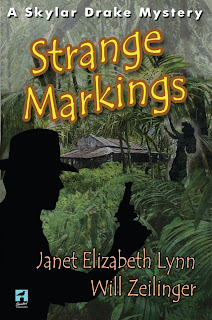When
they met it was murder... like a real Hart to Hart. Authors Janet Elizabeth
Lynn and her husband Will Zeilinger have been writing separately for over a
decade. They’ve recently begun writing the Skylar Drake Mysteries together with
two books out and more on the way. Learn more about Janet and Will at their
websites.
Pre-Statehood Hawaii, Molokai
Island
Strange Markings is the
second in the Skylar Drake Mystery series. The novel begins in San Pedro,
California. The clues lead to pre-statehood Molokai, Hawaii, 1955. Even after
spending hours searching online, we found a research trip to the Hawaii State
Public Library in Honolulu and the Molokai Public Library was a must.
Our first stop was Molokai and its public library, one of three places
on the island that had AC and plenty of drinking water, both of which are in
short supply on the island. We spent hours going through newspapers, telephone
directories, and local magazines from the period. The librarian was more than
helpful, pulling out old materials, blowing off the dust and piling them up on
the table in categories. We were shocked that after 58 years, the town had not
changed that much. Photos of the main street Ala Malama Ave. showed it exactly
the way it looks now. The history of how the island’s ownership of the sugar
mill switched between cattle ranches and crops was like a chess game and played
an important role in the island’s development.
We took notes and gauged our exploration according to what was found in
the newspaper articles. The sugar mill was in ruins but many parts of the
interior and actual mill were intact. As we walked around the overgrown
landscape, our original plot changed drastically, especially the Kapu (curses.)
The locals believed the mill was haunted toward the end of its run.
The trip through the west part of the island was dessert-like, flat,
dry, red dirt and plenty of places to dump dead bodies. On the west side, tropical
foliage with cliffs and beautiful beaches with crashing surf. We took a side
road through hills covered with dense forest and large groups of birds
fluttering and singing. After a short hike on the trail we came across an old
rusty, abandon shack with saplings pushing against the dilapidated roof and
bent sides. A perfect place to hide someone or something illegal perhaps?
The remaining two days on the island were spent interviewing the locals.
Since we were out of our element and had some understanding of the layout of
the island, we asked our usual question, "Where would you dump a dead
body?" We discovered early on that people react differently. Some smiled
and walked away, others didn't even smile when they left. However, quite a few
gave us cross streets, and specific building on the main street to check out.
 |
| Kaunakakai, circa 1950s, looks much the same today. |
The largest town is Kaunakakai, consisting of three blocks of mom and pop
shops, a single traffic light, and one gas station. The population hasn’t grown
very much since the 50's, and the residents love their isolation. Air
conditioning is reserved for the medical center, post office, and library.
There are still many unpaved roads.
Molokai is a time capsule. The growth that occurred on the other islands
has been restricted in Molokai due to insufficient water and electrical resources.
Families still live near the water’s edge and fish for their living. The main
street is still the gathering place for the latest news and gossip.
After Molokai we spent two days in the Hawaii State Public Library to
get an idea of what life was like in 1955 Honolulu. We even found great
articles about the Red Light District, the perfect place for Skylar Drake and
his partner to drown their sorrows. We learned there was a large, well-organized
group of locals opposed to statehood during this time, and politics under the
provincial government in Honolulu was as crooked as it was on the mainland.
Also, traditional Hawaiian music was mostly replaced with Latin music, and Huli-huli
chicken was developed the summer of 1955. It went on to become a popular food
item in Hawaii and the mainland soon after. How about that!
On our second day at the library, the librarian
asked if we’d be interested in some of the legends, superstitions, and curses
from that time. We spent the remainder of the day reading amazing stories,
personal accounts, and research into the origins of many of them.
Strange Markings
The Pacific breezes blow many things in from the ocean. This
time its power, greed, and murder. At the dawn of the television age in 1955,
Skylar Drake is called to identify the remains of a fellow movie stuntman found
buried in a shallow grave. While there, he’s shown mysterious wounds and
strange tattoos on two additional bodies.
A wealthy Bel Air matron sends her enticing niece to enlist
Drake’s help in locating a missing nephew. The search takes him back to
pre-statehood Hawaii where he stopped off on his way to the hell of the Korean
War. Unexplained deaths, politics and superstitious locals turn the tropical
paradise into a nightmare where nothing is what it seems and no one can be
trusted.




No comments:
Post a Comment